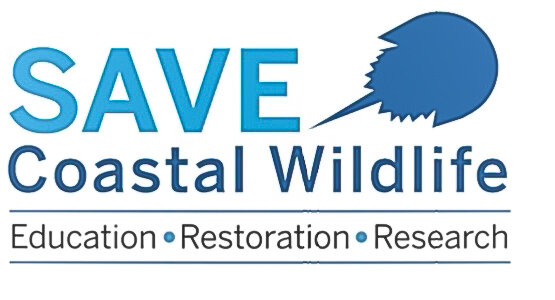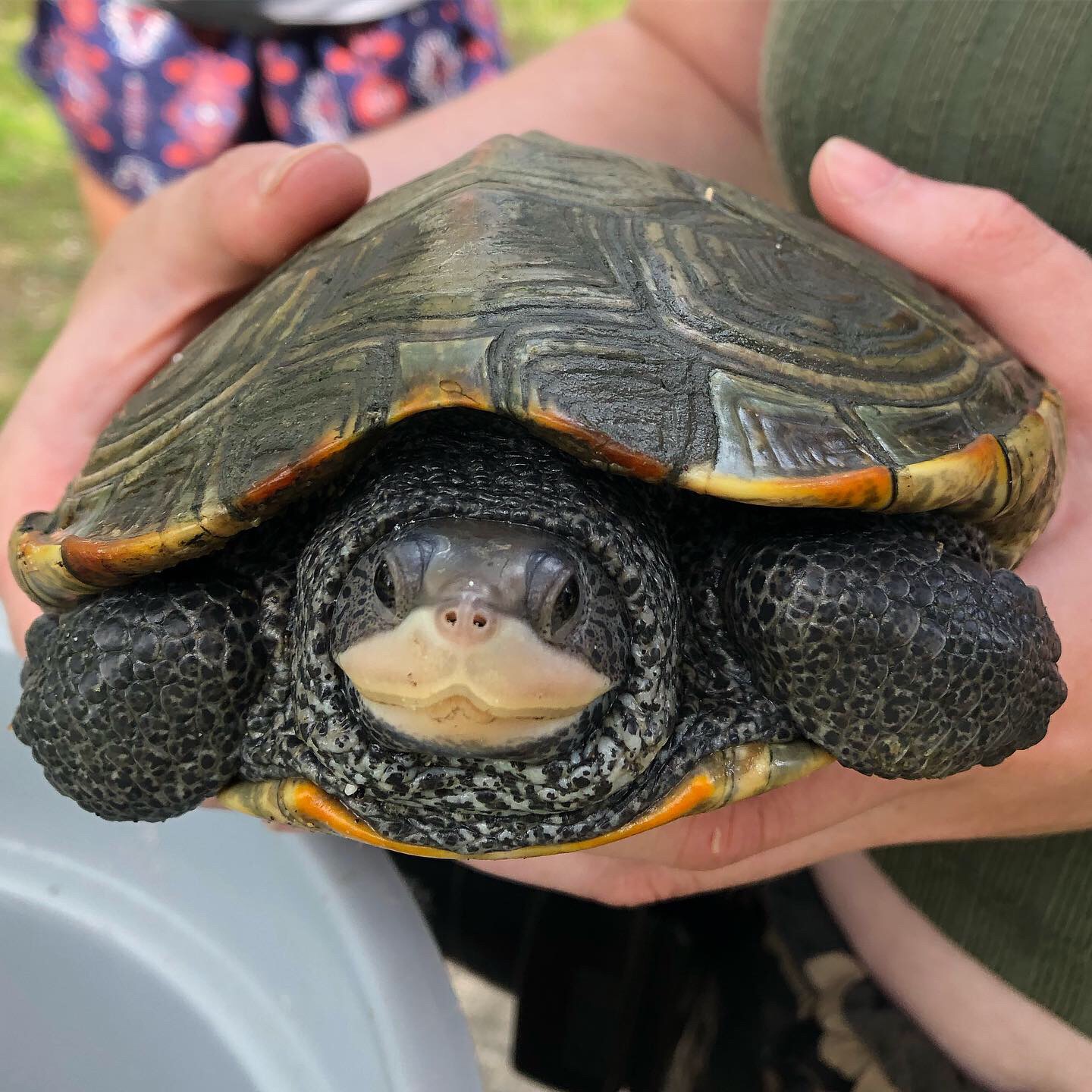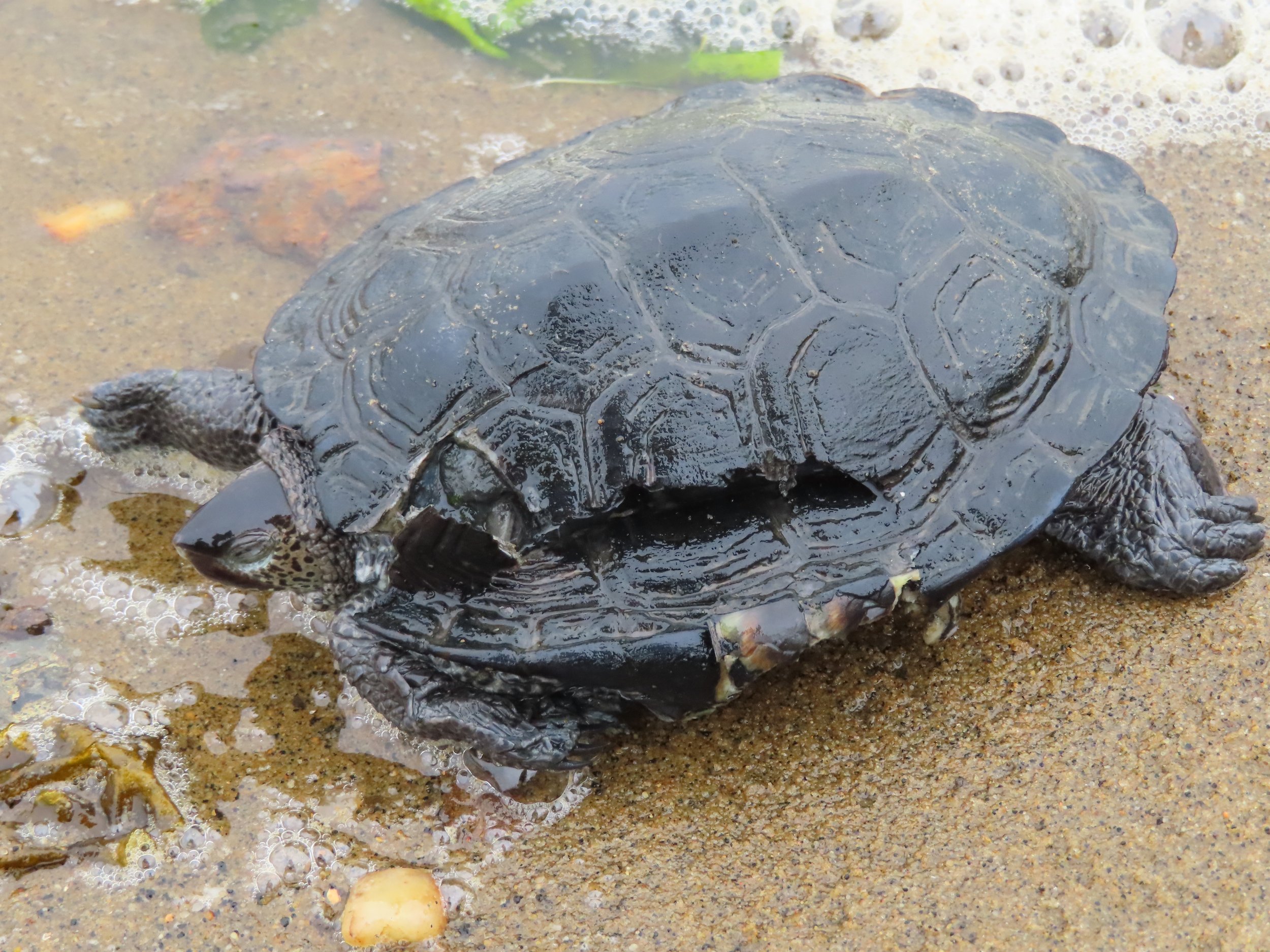SAVE DIAMONDBACK TERRAPINS IN NEW JERSEY
An adult Diamondback terrapin that was run over and killed by a vehicle in New Jersey
What Is A Diamondback Terrapin?
They are not sea turtles and they do not live in freshwater!
Northern Diamondback terrapins (Malaclemys terrapin) are the only brackish water (where salt water from the ocean mixes with fresh water) turtles in the United States, including New Jersey. These unique turtles prefer to live their entire life in salt marshes, tidal rivers and bays.
In addition, since diamondback terrapins are relatively long-lived, with a life span of 30 years or more, occur in a variety of habitats within a salt marsh ecosystem, and females have high site fidelity when nesting, these turtles make useful indicator species for monitoring the health of a estuarine ecosystem.
Diamondback terrapins were once plentiful in tidal wetlands, back-bays and estuarine waters along the Jersey Shore, from Raritan Bay to Delaware Bay. But their population started to dramatically decrease in the 1800s due to habitat loss through increasing coastal development and from unregulated harvesting that supported the demand for turtle soup or terrapin stew. Diamondbacks were a popular gourmet food in the early 1900s at many elegant resort hotels and restaurants along the Jersey Shore. Terrapin or “turtle” soup or stew was a delicacy that could be found alongside shad, lobster, flounder and clams on many restaurant menus. Thankfully, the commercial demand for terrapins ended by the 1930s as a result of decreasing terrapin populations, which made them difficult to find, and Prohibition from 1920 to 1933, which banned the production and sale of sherry, another of the soup's main ingredients.
Unfortunately, human threats to terrapins did not drop. In 2002, the Northern diamondback terrapin was listed as a species of special concern in New Jersey. The listing as special concern “warrants special attention because of some evidence of decline.”
In Massachusetts, the Northern diamondback terrapin turtle is listed as Threatened species. Local populations have fallen dramatically, especially on Cape Cod due to a reduction of salt marsh habitat and alteration of water composition due to ditching, dredging and channelization, and the loss of sandy nesting habitats, and the destruction of dune-beach areas. Poorly planned development has greatly reduced the terrapin’s natural habitat of tidal wetlands, and heavy summer traffic has caused an increase in the number of females struck by cars. Moreover, the increasing numbers of humans on the coast has caused an explosion in local populations of foxes, raccoons, and skunks. These species thrive in proximity to humans, and are the primary predators of terrapin eggs and hatchlings.
In July 2016, New Jersey signed a bill into law to protect diamondback terrapin turtles from illegally being hunted or harvested in response to a growing Asian commercial market for terrapin meat, where terrapins are a popular food item. In September 2017, the New York State Department of Environmental Conservation also adopted a rule to end commercial harvest of diamondback terrapins, responding in part to comments from the Center for Biological Diversity, the New York Turtle and Tortoise Society, HerpDigest and other turtle experts.
Yet, threats to terrapins continue in New Jersey and nearby tidal waters. Although, diamondback terrapins are not sea turtles, just like sea turtles their population is in trouble due to human activities.
THREATS TO DIAMONDBACK TERRAPINS
Drowning in crab Traps & pots
Several male diamondback terrapins found dead in a blue claw crab trap in the Navesink River, 2010.
Diamondback terrapins have noses, not gills, and are air-breathing animals. They need to stick their heads out of the water to take a breath of air.
One Of The Most Significant Threats To Diamondback Terrapins Are Unattended Underwater Traps Intended To Catch Blue-Claw Crabs.
Terrapins are air breathing reptiles, they need to surface to breathe. Diamondback terrapins and blue-claw crabs enjoy eating many of the same food sources, including clams, mussels, small fish and even carrion. Due to this shared interest in food, terrapins are often lured into blue-claw crab traps and drown. Even though terrapins spend the majority of their time in the water hunting for food, and can hold their breath for extended periods of time, a mature terrapin can hold its breath for anywhere from 45 minutes to up to five hours, terrapins trapped in crab traps often drown because they are unable to surface for air for more several hours.
Throughout coastal bays and tidal rivers along the Jersey Shore, crab pot buoys can be seen floating at the water’s surface. Unfortunately, these crab traps can become detached from its buoy or forgotten. These lost pots — known as “ghost pots” — continue to catch crabs and terrapins. Recreational crab traps, as well, can pose a threat to terrapins just like commercial pots. Recreational traps are generally located in shallow water, where terrapins spend a good deal of time, this increases the likelihood of becoming trapped.
Two dead male diamondback terrapin turtles found in a crab trap by a NJ Conservation Officer, July 2010 in the Navesink River, Middletown Township, NJ.
A Bycatch Reduction Device attached to a crab trap to help stop terrapins from entering into a trap and drowning.
Be a responsible crabber! Do not let your crab trap or pot go unattended. Check it regularly. Also, under law, crab traps must be equipped with what's known as a BRD or Bycatch Reduction Device in each entry funnel. They are essentially 4 3/4-inch by 1 3/4-inch doors that allow crabs to enter crab traps but block adult turtles.
Studies suggest BRDs are about 82 percent effective. The trouble is that while BRDs have become standard issue with pots purchased today at local bait shops, a lot of old crab traps don't have them and their owners are either unaware of the law or haven't bothered to retrofit. Yet, these simple devices can be added to crab traps to prevent accidental trapping of terrapins.
By simply attaching bycatch reduction devices (BRDs) to your crab pots, you can help preserve the diversity of animals along the Jersey Shore, while still enjoying your blue-crab catch.
2. Females being hit by vehicles as they cross roadways to nesting sites
Female diamondback terrapins in NJ are getting hit by cars!
Females come ashore to lay clutches of 8-12 eggs from early June into mid-July (but sometimes as early as May) in sandy beaches and other upland gravel areas along the Jersey Shore when tide, temperature, and humidity conditions are right. But this is when problems arise. Each summer, numerous female terrapins are hit by vehicles while crossing roadways to get to sandy beaches in search of their nesting habitat. Most of these injured turtles do not survive, and if this high road mortality continues, the local terrapin population may decline to a dangerously low size.
A dead Diamondback terrapin turtle left on the side of the road.
According to the Wetlands Institute in Stone Harbor, New Jersey: “During the 2007 terrapin nesting season, 382 roadkills were documented on Cape May County roads in the vicinity of Avalon, Stone Harbor, Sea Isle City, and Ocean Drive in Ocean City.” In addition, “in heavy, fast-moving traffic, even if the first driver has time to swerve and avoid hitting a hapless and confused terrapin, other drivers following closely behind often are not able to react to the small creature on the road, and another turtle will be inadvertently killed or maimed….a further problem is caused by the fact that terrapin females nest around the clock. It is virtually impossible for a driver to see a terrapin on the road in the dark.”
Unfortunately, nearly all terrapins that are killed are adult females. Because they can live for 25-30 years and can continue to reproduce for two decades, every female lost is also a loss of all her potential offspring. One solution is more sandy beach habitat around estuaries, but sandy beaches are becoming rare as more shorelines are hardened with bulkheads, rip rap and stone to protect nearby homes from sea level rise.
While driving on coastal roads in June and July, be aware of any turtles that may be crossing the road to nest. If you see a turtle crossing the road, move it to the side that it is headed, if it is safe for you to do so. Do not take the turtle to a "safer" place. Remember, turtles have a home area that they are familiar with and they will try to return there.
Brake for turtles! If you spot a turtle in the road, always be sure to stop.
A female diamondback terrapin making a nest along the Jersey Shore to eventually lay on average between 6 to 10 eggs, perhaps as many as 14 eggs. A female will lay one egg at a time and will catch each egg with one of their rear feet to position the egg in the nest before the next egg drops onto the ground.
3. The Diamondback Terrapin Pet Trade!
A juvenile diamondback terrapin found in a wetland along the northern Jersey Shore.
WE KNOW THEY ARE CUTE, BUT PLEASE DO NOT KEEP A DIAMONDBACK TERRAPIN AS A PET! PLEASE KEEP THESE BEAUTIFUL ANIMALS WILD!
Diamondback terrapins are continually being poached by people as either individual pets or for the international pet trade. Recently, in July 2018, a Pennsylvania man was indicted on charges of trafficking more than 3,500 protected diamondback terrapin turtles and their eggs from coastal marshes in southern New Jersey.
Diamondback terrapins around New Jersey, New York and other nearby states are frequently being illegally harvested and smuggled out of the country because of increased demand for pets and turtle meat in some parts of Asia, especially in Southeast Asia, including the Chatuchak Market in Bangkok, Thailand. This location has a terrible and well-known history of being a hub of illegal reptile trafficking, as turtle meat is traditionally viewed as a symbol of longevity.
All turtles should stay in the wild. Not only is collecting a diamondback terrapin illegal in many states, but it can hurt the population. A terrapin taken from the wild will often become sick and die. When a captive turtle is released, it is often killed by predators or run over by vehicles as it tries to return to its original home from unfamiliar surroundings.
Severe health issues can arise when a turtle, or any other wild animal, is kept as a pet. All animals have very specific nutritional and management requirements. Improper housing and food can cause irreparable damage. If you find a coastal animal in New Jersey or New York and believe it needs assistance please call local police or a wildlife rehabilitator; they will help determine the appropriate course of action. It is also not legal to release an unwanted pet to the wild.
Do not keep a diamondback terrapin as a pet! Diamondback terrapins will almost certainly die in captivity because they do not naturally occur in freshwater. Most people do not have the necessary salt water aquaria in their homes to provide adequate care for the terrapins. This equipment is very expensive and difficult to maintain.
Question: What about pet stores. Can a local pet store sell baby turtles?
Not if turtles have shell lengths less than four (4) inches. Federal regulations state that turtles offered for sale are required to have shell lengths greater than four inches. These regulations were created to address concerns that small children might put turtles into their mouths and contract Salmonellosis. Salmonella bacteria can sometimes be found on pet turtles that have been kept in captivity. The US Food and Drug Administration and the US Fish and Wildlife Service enforce these federal regulations.
4. THE LOSS OF TERRAPIN HABITAT
WE ARE LOSING WETLANDS AND NATURAL COASTLINES TO POORLY PLANNED DEVELOPMENT.
A female Diamondback terrapin in the process of laying eggs near the Navesink River, NJ.
Support saltmarsh conservation. Protecting and preserving saltmarsh habitats is essential for the survival of diamondback terrapins, not to mention many other unique wildlife!
Increased runoff and sewage in waterways, pollutants, dredging, and the filling of salt marshes, and the development and maintenance of shipping channels all pose significant threats to terrapin habitat. Coastal development in bays and estuaries along the Jersey Shore is particularly problematic because it frequently destroys nesting beaches.
Traditional nesting areas have been severely and permanently altered by waterfront development. Beach habitat is critical to the continued existence of terrapins.
Diamondback terrapins have very specific habitat requirements. They inhabit brackish and saltwater estuarine habitats including bays, rivers, sounds, tidal creeks, and coastal marine habitats. Little is known about the habitat use of juvenile terrapins although it is thought they spend much of their early life hiding under mats of decaying marsh grass.
Adult terrapins are known to have very high site fidelity, often spending their entire adult life in the reaches of a single tidal creek.
During colder winter months, terrapins may hibernate buried in mud on the creek bottom or in creek banks near the high tide line. Most terrapins become inactive by November, and begin to appear again in late Marsh and April. Female terrapins are sexually mature at approximately 5 years of age while males mature somewhat faster at 3 years of age.
Research indicates that more than 95 percent of breeding females return to a particular area to nest year after year.
As an alternative to bulkheads and riprap, members of Save Coastal Wildlife recommend installing a Living Shoreline, such as a beach or tidal wetland that can reduce wave energy, trap sediment, and filter runoff, while maintaining (or increasing) wildlife habitat. A natural living shoreline will protect Diamondback terrapin populations while providing areas for feeding and nesting.
5. Illegally Exporting Turtles to Asia
People are selling & illegally trafficking turtles from New Jersey, especially diamondback terrapins, which are valued as meat and pets in many parts of Asia including China.
In China, turtle meat and blood are prized food and medicine, and juvenile turtles are valued as pets. But the demand for turtles is so great that China has eaten or exhausted through their own turtle populations. More than half the estimated 90 species of water turtles and tortoises in the region are now listed as "endangered" or "critically endangered" by the World Conservation Union (IUCN), victims of habitat destruction, the pet and ornamental trades and, most dramatically, the insatiable appetite of the Chinese for turtles as food and traditional medicine. The turtle, which is an Asian icon of longevity, happiness and wisdom, is now being annihilated and headed toward extinction in Asia.
Turtles in the United States, including New Jersey, are now making good targets to fill an international demand for pets, medicine, and meat. Chinese traders are working with traffickers in Vietnam, Laos, Myanmar and Bangladesh, Malaysia and Indonesia. For example, in Laos, turtle are believed to cure cancer. A live turtle can fetch more than $1,200 (U.S. dollars) per animal--about three times the average’s person income.
In 2019, David Sommers, 64, of Levittown, Pennsylvania pleaded guilty of smuggling 11 diamondback terrapin hatchlings and sending them to Canada. He was also earlier found with plucking some 3,500 diamondback terrapins and their eggs from the coastal marshes of southern New Jersey and selling them in violation of the Lacey Act, a federal statute that prohibits the trafficking of wildlife captured or killed in jurisdictions where it is illegal.
In December 11, 2020, a Chinese national was put in federal custody in New Jersey after investigators said he financed an international smuggling ring that shipped more than 1,500 turtles from the United States to China, valued at more than $2.2 million. The turtles, many of which were bound with duct tape, stuffed into socks and shipped in mislabeled packages, were sold for as much as $20,000 each on the Asian pet black market, authorities said.
Other Threats:
Predators are increasing as trash increases in our environment and crowding out terrapins from their narrow coastal habitat. Diamondback terrapins and their eggs are known to be taken by many predators including raccoons, foxes, skunks, Norway rats, crows, and gulls.
An adult Diamondback terrapin that was killed by being hit from a boat’s propeller in the Navesink River 2020.
Unfortunately, surging populations of predators along the coast, including raccoons, gulls, rats, and foxes, from increasing amounts of trash and litter on beaches and in our communities are doing wide-spread damage to populations of diamondback terrapins. Studies in New York State have identified raccoons and Norway rats as major predators on the adults, juveniles, and eggs of the terrapin.
Females do not reach maturity until a minimum of 5 years of age. A single female diamondback terrapin produces only about 10-15 pinkish-white eggs per year (and may not nest every year). The low reproductive potential of terrapins means that females must reproduce for many years in order for the population to grow or remain stable.
It is estimated that only two percent of terrapin eggs hatch, owing largely to predation by foxes, skunks, and raccoons, which dig into the nests and consume the eggs and baby terrapins. Survivors emerging from the nest are often eaten by gulls and crows or by herons and predatory fish after entering the water.
Sea level rise and climate change are also potential threats to terrapins and their salt marsh habitat.
Mercury Contamination has as well been recently found in Diamondback Terrapins in New Jersey, specifically at two study sites: Cape May and the Hackensack Meadowlands.
Save Diamondback Terrapins Along the Jersey Shore!


















